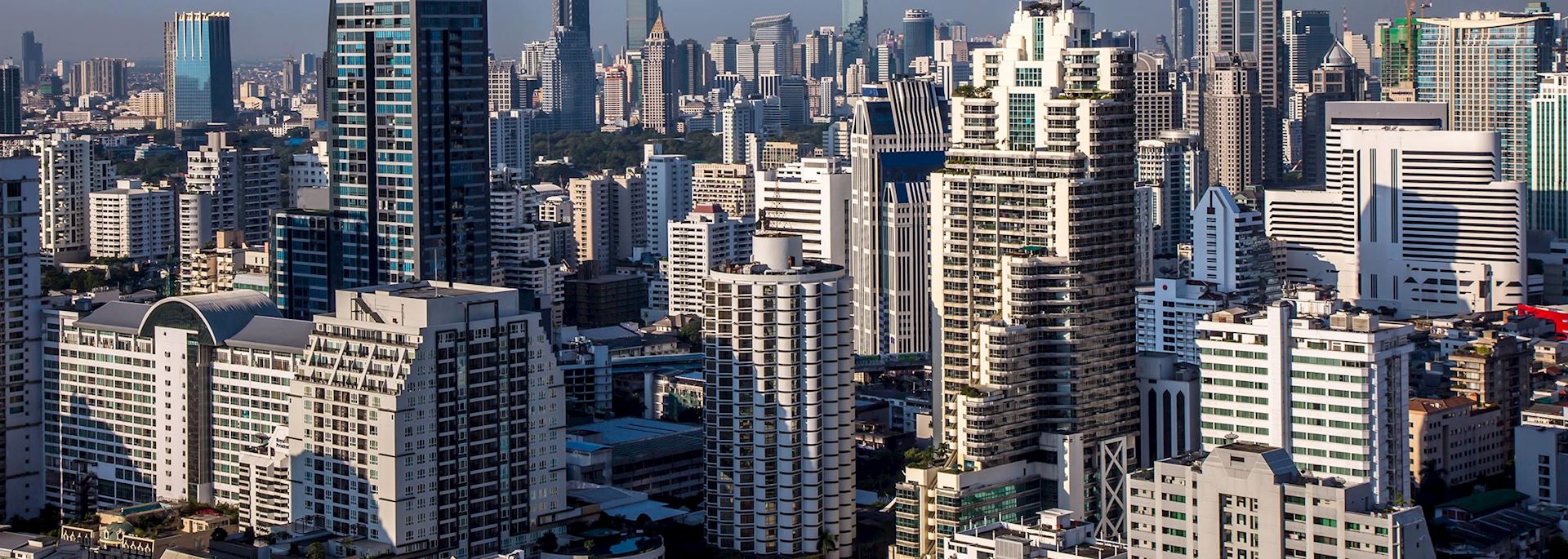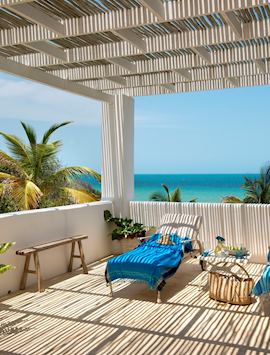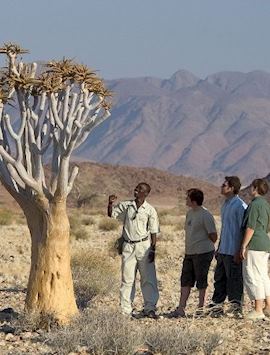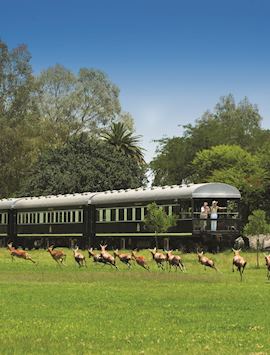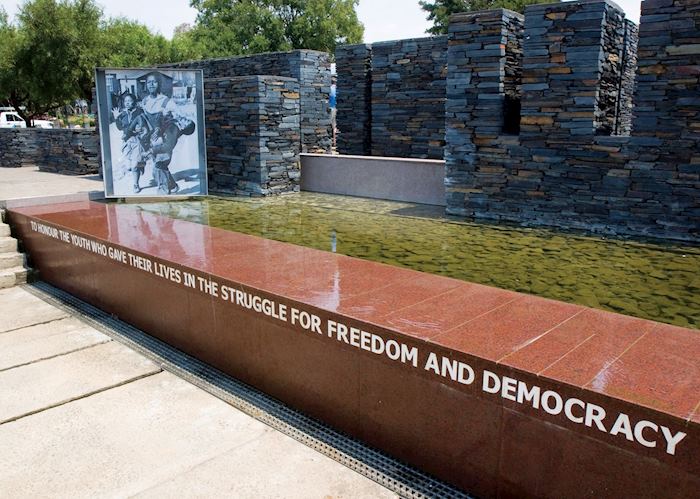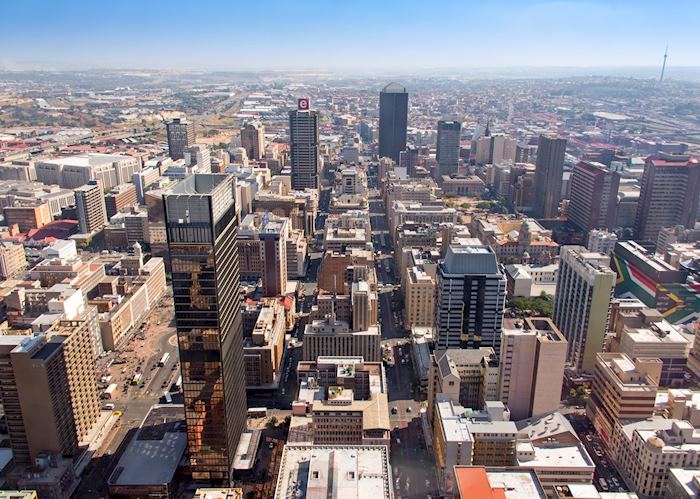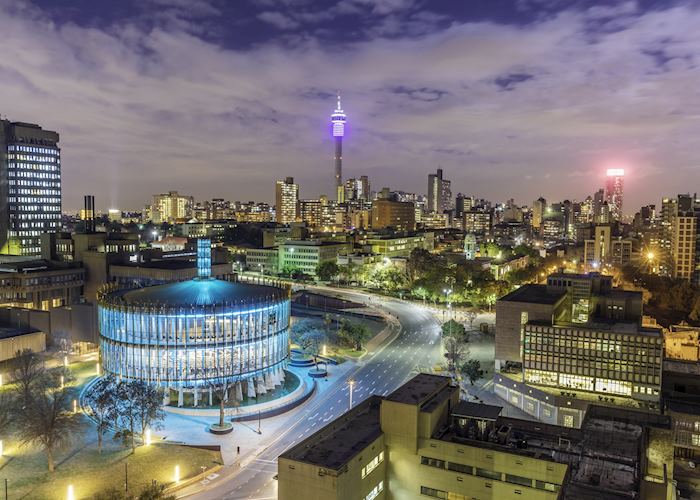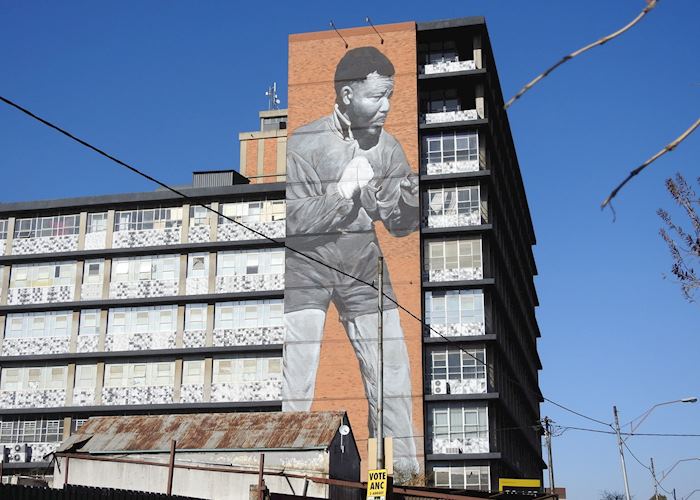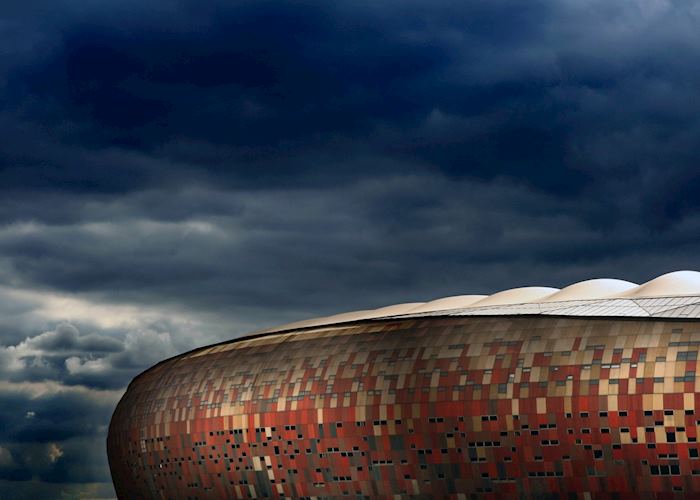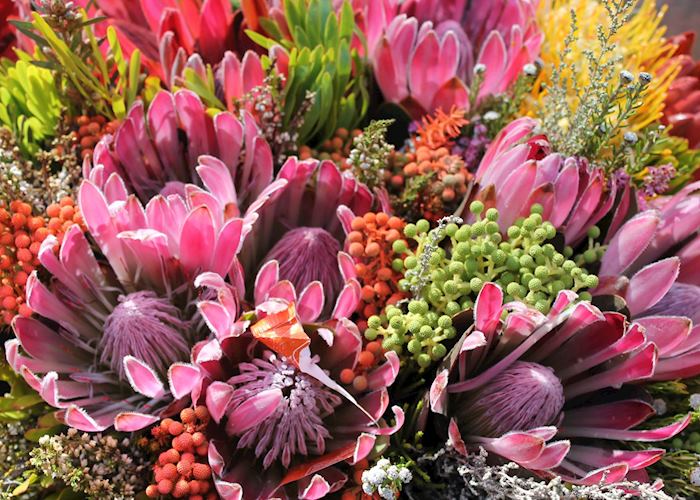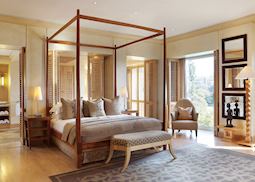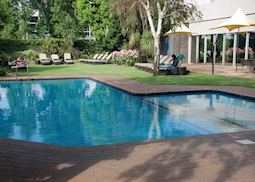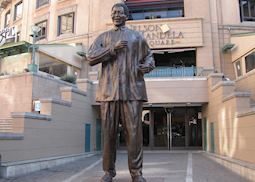Jump to:
Born out of a late-19th-century gold rush, Johannesburg — or Egoli, meaning ‘place of gold’ in Zulu — rapidly grew to become South Africa’s economic engine. Today, the city’s many ethnicities and cultures can be explored through its food, music and thriving arts scene.
It’s also a place of stark contrasts, where leafy suburbs of high-walled mansions are juxtaposed with sprawling, corrugated shanty towns. This gaping difference in fortune is partly a result of the ruthless apartheid regime that swept the nation during the 20th century. Places like the Apartheid Museum, Constitution Hill and Liliesleaf Farm paint a picture of these turbulent years.
While the city is undergoing rapid regeneration in up-and-coming pockets like Maboneng Precinct, Johannesburg is rawer than Cape Town. It’s a city that’s both deeply rooted in its past yet forward-thinking and optimistic about its future.
Johannesburg is a real African city whose resilience shines through in the vibrant culture and creativity of its people. My highlight is the Maboneng Precinct, which is stuffed full of art and foods that reflect modern-day South Africa.
South Africa specialist Paul
Things to see and do in Johannesburg
Johannesburg, Soweto and Apartheid Museum tour
The effects of the apartheid era are still felt in some of Johannesburg’s poorer areas. One of these is Soweto — South Africa’s most densely populated black urban residential area. Many black people were relocated to here from other parts of the city reserved for whites during the 20th century, forming the South Western Townships (later shortened to Soweto).
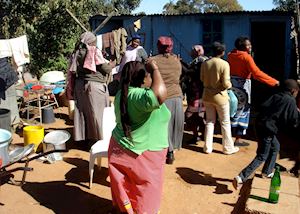 Overcrowding in Soweto led to families living in corrugated-iron shacks, creating sprawling shanty towns that are still occupied today. However, the sense of community is strong, and even those now better off often choose to remain in the township, forming middle-class suburbs.
Overcrowding in Soweto led to families living in corrugated-iron shacks, creating sprawling shanty towns that are still occupied today. However, the sense of community is strong, and even those now better off often choose to remain in the township, forming middle-class suburbs.
You can take a full- or half-day guided walking tour that explores vastly contrasting areas of Johannesburg, from the affluent northern suburb of Houghton with its mansions and leafy streets, to the inner city’s mix of neglected buildings that are gradually being regenerated, to the poorer areas of Hillbrow (a deprived inner-city district) and Soweto.
Along the way, you’ll learn about the inner workings of the Supreme Court and discover the symbolism behind Gandhi Square, as well as paying a visit to the Apartheid Museum. Housed in a stark white building, its eye-opening exhibits include sound clips, photographs and documentaries, detailing the horrors of those years, including first-hand accounts from those affected. It also covers the life and achievements of Nelson Mandela through to his release from prison in 1990 after serving 27 years behind bars.
Liliesleaf Farm
Situated in the northern suburb of Rivonia, Liliesleaf Farm was once the meeting place of those leading the anti-apartheid liberation movement during the early 1960s. This included members of the ANC (African National Congress), which was made illegal in 1960, forcing it to go underground. The farm also provided a place of refuge for political fugitives such as Nelson Mandela. He lived here between 1961 and 1962 under the alias of David Motsamayi, posing as a farm worker.
On 11th July 1963, the group were conducting a meeting when the farm was raided by police, resulting in the arrest of 19 members, eight of whom received life sentences.
You can visit the farm, today a museum, to gain a detailed insight into the events leading up to the raid and the political landscape at that time. After watching a short introductory film, you’re free to wander around the farm buildings, each of which has exhibits related to apartheid, the lives of those who met here, the raid itself, and Nelson Mandela’s fight for freedom.
Maboneng Precinct
Far from many people’s perceptions of Johannesburg, the trendy Maboneng Precinct in the east of the city is a hub of art, food, cafés and boutiques. Once a deprived area rife with crime, vacant buildings and derelict warehouses, the regeneration of Maboneng (which means ‘place of light’ in Sotho) began in 2008. Developer Jonathan Liebmann bought some of the rundown buildings with the aim of transforming them into places where art and culture could thrive.
The result is Arts on Main, a former warehouse that now hosts artists’ studios, galleries, restaurants, cafés and independent shops. On Sunday mornings (and the evening of the first Thursday of the month) it also holds the Market on Main — an extravaganza of food stalls, locally made crafts, clothing and accessories that demonstrates the city’s multicultural heritage and creative flair. You can sample the likes of Ethiopian curry and bunny chow (curry served in hollowed-out bread originating from Durban), or purchase a Maasai belt.
To appreciate fully the vibrant street art that’s brightly splurged across many of the buildings in Maboneng and other nearby areas, you can take a three-hour public art tour with a local guide. Your guide will explain the meaning behind some of the murals and how they reflect modern life in Johannesburg, as well as telling you more about the history of Maboneng and the wider city.
Constitution Hill
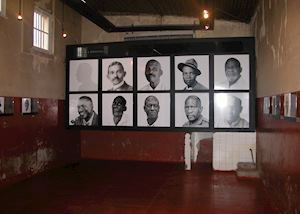 This living museum has in the past been both a prison and a military fort. Among its inmates were Gandhi, Mandela, Joe Slovo and, in the women’s prison, Albertina Sisulu and Winnie Madikizela-Mandela. The building is now aptly home to the Constitutional Court, which endorses human rights for all. A visit gives you an overview into the judicial system, both past and present, with a variety of guided tours offered each day.
This living museum has in the past been both a prison and a military fort. Among its inmates were Gandhi, Mandela, Joe Slovo and, in the women’s prison, Albertina Sisulu and Winnie Madikizela-Mandela. The building is now aptly home to the Constitutional Court, which endorses human rights for all. A visit gives you an overview into the judicial system, both past and present, with a variety of guided tours offered each day.
There are a number of other tours you can join. The Walk with Madiba Tour focuses on Nelson Mandela (the only black prisoner kept in the white section of the prison amid fears that he would influence other black inmates). Another option sees you dress up in prison uniform and undertake inmate tasks. And, for a particularly atmospheric experience you can tour the prison at night.
As you explore the buildings where prisoners were forced to live in incredibly poor conditions, you can read and watch exhibits about the treatment of inmates, as well as the wider story of the struggles under apartheid and the country’s hard-fought journey to democracy.
The Cradle of Humankind: Sterkfontein Caves and Maropeng
Around 50 km (31 miles) northwest of Johannesburg lie the Sterkfontein Caves, part of the Cradle of Humankind World Heritage Site — a huge network of limestone caves. More than one third of the world’s oldest hominid fossils have been discovered in this area, allowing palaeontologists to piece together human evolution.
Some of the most significant fossils were found in the Sterkfontein Caves, including ‘Mrs Ples’ and ‘Little Foot’. The former dates back 2.3 million years and is one of the most complete early-human skulls ever found. The latter is an almost complete skeleton dating back nearly three million years.
You can head deep underground with a guide to see some of the sites where fossils lay undisturbed for millennia. As you descend, markers on the floor indicate how many thousands or millions of years old that part of the caves is and which species would have been living at that point. You soon learn that the lifespan of human existence barely scratches the surface of the Earth’s history.
Before venturing into the caves, we recommend a visit to the nearby Maropeng Visitor Centre for an overview of the Cradle of Humankind. Situated underground, its interactive exhibits and displays tell you more about the site and human evolution. Some of the skulls of different hominid species are lined up in chronological order, which allows you to pick up on subtle differences in their shape.
The Satyagraha House: Gandhi’s former residence
Between 1893 and 1914, Mahatma Gandhi lived in South Africa. He’s believed to have begun to develop his philosophy of passive resistance (known as ‘Satyagraha’ in Sanskrit) here, which he held for the rest of his life and helped him in the fight for Indian independence.
For a year between 1908 and 1909, Gandhi lived in the building that’s now the Satyagraha House — a guesthouse and museum in northern Johannesburg that pays homage to his way of thinking. The exterior of this traditional farmhouse-style thatched building has changed little since its construction in 1907, having been sensitively restored by a team of historians and curators.
Inside, the seven simple but comfortable guest rooms, spread between the main house and a more modern wing, align with Gandhi’s modest lifestyle. Even the food is vegetarian-only and alcohol-free.
You don’t have to be a guest to appreciate the Satyagraha House; its museum is open to the public between 10am and 4pm every day. As a visitor, you can climb the staircase to see Gandhi’s loft bedroom, which has been set up to look as it did during his residency. You can also explore the exhibits that detail Gandhi’s life and work, with staff on-hand to tell you more. There are also peaceful gardens to stroll, which make it easy to forget you’re on the perimeter of one of South Africa’s busiest cities.
Best time to visit Johannesburg
Johannesburg can be visited at any time of year, but the best conditions can be experienced during the spring (October and November), when you can also see jacaranda trees in bloom, and during autumn (March and April), when you can see the leaves change from green to red and yellow. The summer months (December to February) often experience afternoon thunderstorms, while the temperatures drop to single figures in the winter (May to July).
Festivals, events and seasonal reasons to visit
- The outdoor Neighbourgoods Market takes place every Saturday in the central suburb of Braamfontein. A popular haunt with locals, it sells a wide mix of multicultural foods, clothes, accessories, crafts and antiques.
- Taking place on the first Thursday of every month, First Thursdays sees art galleries and other cultural attractions in the Braamfontein, Maboneng and Rosebank areas open late, allowing you to explore the city and its art scene on foot at a more unusual time of day.
who's been there

Start planning your tailor-made trip to Johannesburg by contacting one of our South Africa specialists
-
01993 838 92501993 838 550
- Make an enquiry
Reduced fares currently available through our airline partners
We have a number of reduced fares available with selected airline partners. Click below for further details on booking and travel periods.
View offersSuggested itineraries featuring Johannesburg
Our itineraries will give you suggestions for what is possible when you travel in Johannesburg, and they showcase routes we know work particularly well. Treat them as inspiration, because your trip will be created uniquely by one of our specialists.
Places near Johannesburg
- The Pilanesberg National Park 89 miles away
- The Waterberg 116 miles away
- The Madikwe Game Reserve 149 miles away
- The Escarpment 192 miles away
- Spioenkop 193 miles away
- Blyde River Canyon Nature Reserve 207 miles away
- Hazyview 209 miles away
- Eswatini 216 miles away
- Greater Makalali Game Reserve 217 miles away
- The Battlefields 218 miles away
- Kapama Private Game Reserve 226 miles away
- Thornybush Reserve 230 miles away
- Southern & Central Sectors Kruger National Park 233 miles away
- Sabi Sands Game Reserve 234 miles away
- The Drakensberg 236 miles away
- Lesotho 236 miles away
- Timbavati Game Reserve 242 miles away
- Kruger National Park 259 miles away
- The Midlands 265 miles away
- Thanda Safari Private Game Reserve 275 miles away
- Hluhluwe-iMfolozi Park 278 miles away
- Phinda Private Game Reserve 287 miles away
- Lake St Lucia 300 miles away
- iSimangaliso Wetland Park 300 miles away
Photos of Johannesburg
Accommodation choices for Johannesburg
We've selected a range of accommodation options for when you visit Johannesburg. Our choices usually come recommended for their character, facilities and service or location. Our specialists always aim to suggest properties that match your preferences.
-
![Saxon Boutique Hotel & Spa, Johannesburg]()
Saxon Boutique Hotel & Spa
Johannesburg -
![Pool, Southern Sun O.R. Tambo International Airport]()
The Southern Sun
Johannesburg -
![Intercontinental O.R.Tambo International Airport, Johannesburg]()
InterContinental O.R.Tambo International Airport
Johannesburg -
![The Peech Hotel, Johannesburg]() Responsible ChoiceWe've hand-selected a range of tours and stays across the world that go above and beyond to be a force for good by supporting local businesses, educating staff, challenging local norms, or promoting conservation and biodiversity efforts. Your Responsible Choice helps increase the positive impact of your trip.
Responsible ChoiceWe've hand-selected a range of tours and stays across the world that go above and beyond to be a force for good by supporting local businesses, educating staff, challenging local norms, or promoting conservation and biodiversity efforts. Your Responsible Choice helps increase the positive impact of your trip.The Peech Hotel
Johannesburg
Ideas for experiencing Johannesburg
Our specialists seek out authentic ways to get to know the places that could feature in your trip. These activities reflect some of the experiences they've most enjoyed while visiting Johannesburg, and which use the best local guides.
-
Johannesburg, Soweto & Apartheid Museum tour ![Nelson Mandela Square, Johannesburg, South Africa]()
Johannesburg, Soweto & Apartheid Museum tour
Johannesburg, Soweto & Apartheid Museum tour
You’ll explore the contrasting areas of Johannesburg and its surroundings on this full-day tour, from the leafy suburb of Houghton to the inner-city residential area of Hillbrow, the township of Soweto, and the city’s modern heart.
View details

